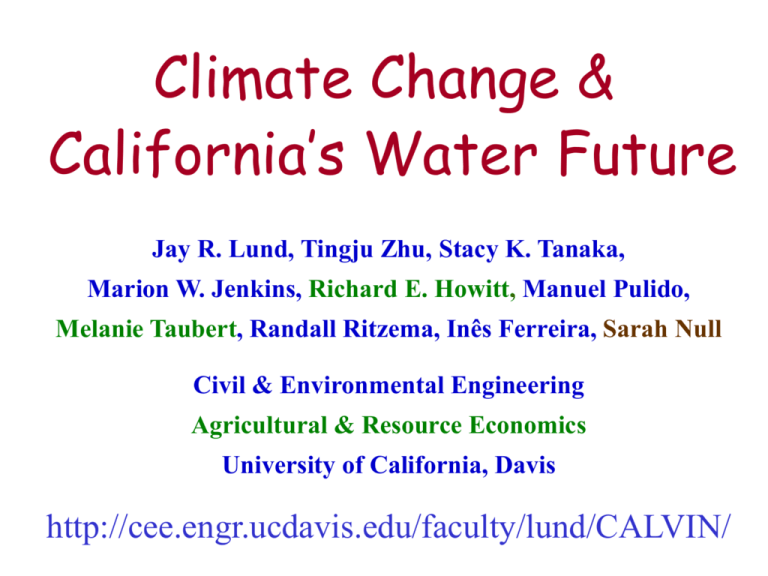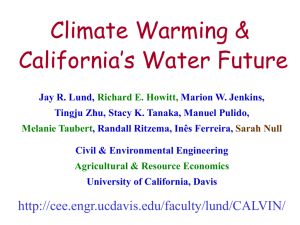PowerPoint pres. - California Water and Environmental
advertisement

Climate Change & California’s Water Future Jay R. Lund, Tingju Zhu, Stacy K. Tanaka, Marion W. Jenkins, Richard E. Howitt, Manuel Pulido, Melanie Taubert, Randall Ritzema, Inês Ferreira, Sarah Null Civil & Environmental Engineering Agricultural & Resource Economics University of California, Davis http://cee.engr.ucdavis.edu/faculty/lund/CALVIN/ 1 Tantalus In Hades, thirsty Tantalus was burdened to have water rise to his neck threatening to drown him, but receded when he stooped to drink. Above him was a boulder, threatening to crush him at some uncertain future time. How like California water management! 2 Change "Change has considerable psychological impact …. To the fearful it is threatening because …things may get worse. To the hopeful it is encouraging because things may get better. To the confident it is inspiring because the challenge exists to make things better. … One’s character and frame of mind determine how readily he brings about change and how he reacts to change that is imposed on him." - King Whitney Jr. 3 Overview 1. Climate Change in California Historical, Pre-historical, Future 2. Adaptation to Climate Warming Warming and water demand scenarios Options for adaptation Analysis for promising adaptations and performance 3. Conclusions 4 Historical climate variability Roughly 100 years of record Two 6-year droughts One 2-year drought Other odd dry years Correlation of droughts with Pacific Decadal Oscillation (PDO) – Scripps, and others 5 Pre-historical variability 1) Last 1,000 years a) Scott Stine - Lake with long droughts b) Meko – Streamflow fluctuations – tree rings c) Others – Long term lake fluctuations – PDO connection for some droughts 2) Earlier Holocene (10,000 years) a) Multi-decade and Multi-century droughts – lake and estuary sediments b) Tahoe reaches sill 3,000 years ago 6 Past sea level rise Steady long-term rise since Ice Age’s end Delta is a drowned river valley, 10,000 years old < California has always been a dynamic place? 7 Future Climate Changes 1) Sea level rise 2) Climate Variability 3) Climate Warming 4) Other forms of climate change? 8 Future sea level rise Certain occurrence Rate is significant, but somewhat uncertain (about 1ft/century?) Some coastal implications Potential Delta water quality and flooding implications in 50-100 years (Anderson) 9 Future Climate Variability Almost certain to continue. El Nino Southern Oscillation – ENSO Pacific Decadal Oscillation – PDO Other forms of variability? 10 Climate Warming 1) Seems very likely 2) Some effects already seen in California? Earlier snowmelt in recent decades Is it greenhouse warming or PDO change? 3) Wet or dry warming? 4) CO2 and other changes… 11 Climate Warming Effects? 1) Shift in snowmelt season 2) Changes in: Crop ETAW and yields Watershed and reservoir ET Urban water use Ecosystems (T, nutrients, CO2, etc.) 3) Wet or dry warming? Some changes are clear, others uncertain. 12 Other forms of climate change? Who knows? Varying solar intensity, … Still a new subject. How will different forms of climate change combine? 13 Conclusions about climate change California’s climate has always changed Maybe last century was lucky Additional climate changes seem likely Changes will affect water system operations Would changes affect system performance? How can our water system adapt? 14 Climate Warming and Water Management Preliminary study of climate warming for water management in California 2100 climate warming and population growth scenarios CALVIN model identifies promising adaptations to climate and population changes Preliminary results Conclusions Thanks to California Energy Commission for funding! 15 2100 Climate Changes 1. Water availability changes estimated for 12 climate warming scenarios (based on LBNL). 2. Water supply impacts estimated for: a. Major mountain inflows b. Groundwater inflows c. Local streams d. Reservoir evaporation 3. Effects estimated for 113 inflows distributed throughout California 16 2100 Climate Changes 9000 1.5T 0%P 3.0T 0%P 5.0T 0%P HCM 2010-2039 HCM 2080-2099 PCM 2050-2079 Historical Total Monthly Mean Rim Inflow (TAF) 8000 7000 1.5T 9%P 3.0T 18%P 5.0T 30P HCM 2050-2079 PCM 2010-2039 PCM 2080-2099 6000 5000 4000 3000 2000 1000 0 1 2 3 4 5 6 7 Calendar Month 8 9 10 11 12 17 2100 Raw Water Availability Climate Scenario Average Annual Water Availability Vol. Change maf maf Climate Scenario Average Annual Water Availability Volume Change maf maf 1) 1.5T 0%P 35.7 -2.1 7) HCM 2025 41.9 4.1 2) 1.5T 9%P 37.7 -0.1 8) HCM 2065 40.5 2.7 3) 3.0T 0%P 33.7 -4.1 9) HCM 2100 42.4 4.6 4) 3.0T 18%P 37.1 -0.8 10) PCM 2025 35.7 -2.1 5) 5.0T 0%P 31.6 -6.2 11) PCM 2065 32.9 -4.9 6) 5.0T 30%P 36.2 -1.6 12) PCM 2100 28.5 -9.4 37.8 0.0 Historical 18 2100 Population & Land Use 1. Future population and land use will greatly affect water demands. 2. With growth to 92 million (UCB), urban demands grow by ~ 7.2 maf/yr 3. Urbanization of irrigated land reduces agricultural demands by ~ 2.7 maf/yr 4. Net effect is big (+4.5 maf/yr) and economically important 19 What is CALVIN? • Model of entire inter-tied California water system • Surface and groundwater systems; supply and demands • Economics-driven optimization model – Economic Values for Agricultural, Urban, & Hydropower Uses – Flow Constraints for Environmental Uses • Prescribes monthly system operation over a 72-year representative hydrology Maximizes economic performance within constraints 20 CALVIN’s Spatial Coverage Over 1,200 spatial elements 51 Surface reservoirs 28 Ground water reservoirs 600+ Conveyance Links 88% of irrigated acreage 92% of population 21 Economic Values for Water • • • • Agricultural: Production model SWAP Urban: Demand model based on price elasticities Hydropower Operating Costs: Pumping, treatment, water quality, etc. Environmental flows and deliveries as constraints – with first priority 22 Data Flow for the CALVIN Model Surface and ground water hydrology Physical facilities & capacities Environmental flow constraints Urban values of water (elasticities) Agricultural values of water (SWAP) Operating costs Economic benefits of alternatives CALVIN Economic Optimization Model: Databases HECPRM of Input & Solution Meta- Data Model Conjunctive use & cooperative operations Willingness-to-pay for additional water & reliability Water operations & delivery reliabilities Value of more flexible operations Values of increased facility capacities 23 Integrated Adaptation Options • Water allocation (markets & exchanges) • System operations • Conjunctive use • Coordinated operations • Urban conservation/use efficiencies • Cropping changes and fallowing • Agricultural water use efficiencies • New technologies • Wastewater reuse • Seawater desalination 24 Model Limitations 1) Data: Base hydrology, Tulare Basin, monthly agricultural demands, etc. 2) Network flow formulation, simplified costs, water quality, environmental requirements, hydraulics, hydrologic foresight and coordination 3) Limited range of benefits No flood control or recreation 25 Alternative Conditions 1) Base 2020 – Current policies for 2020 2) SWM 2020 – Statewide water market 2020 3) SWM 2100 – SWM2020 with 2100 demands 4) PCM 2100 – SWM2100 with dry warming 5) HCM 2100 – SWM2100 with wet warming 26 Accretions - Depletions + Rim Inflows + Groundwater Inflows - Reservoir Evap (maf/yr) Climate Scenarios by Region 30 26.6 Historical PCM2100 HCM2100 25 20 17.6 16.5 15.6 15.2 15 11.8 11.3 9.9 10 8.8 8.5 8.4 6.4 4.5 4.2 4.9 5 0 Upper Sac. L.Sac&BayDelta S.Joaq&S.Bay Tulare 27 So.Cal Some Early Results • Delivery, Scarcity, and Economic Performance • Conjunctive Use and other Operations • New Technologies • Costs of Environmental Flows • Flood Frequency • Hydropower Performance • Economic Value of Facility Changes 28 Scarcity, Operating, & Total Costs ($ million/yr) Cost Base 2020 SWM 2020 SWM 2100 PCM 2100 HCM 2100 Urban Scarcity 1,564 170 785 872 782 Agric. Scarcity 32 29 198 1,774 180 Operating 2,581 2,580 5,918 6,065 5,681 Total Costs 4,176 2,780 6,902 8,711 6,643 29 Base2020 SWM2020 SWM2100 PCM2100 HCM2100 Base2020 SWM2020 SWM2100 PCM2100 HCM2100 Base2020 SWM2020 SWM2100 PCM2100 HCM2100 Scarcity 40 Deliveries Upper Sac L.Sac&BayDelta S.Joaq&So.Bay Tulare So.Cal Base2020 SWM2020 SWM2100 PCM2100 HCM2100 45 Base2020 SWM2020 SWM2100 PCM2100 HCM2100 Base2020 SWM2020 SWM2100 PCM2100 HCM2100 Annual Average Delivery and Scarcity (maf/yr) Total Deliveries and Scarcities 50 35 30 25 20 15 10 5 0 30 Statewide Base2020 SWM2020 SWM2100 PCM2100 HCM2100 Base2020 SWM2020 SWM2100 PCM2100 HCM2100 Base2020 SWM2020 SWM2100 PCM2100 HCM2100 Upper Sac L.Sac&BayDelta S.Joaq&So.Bay Tulare So.Cal Base2020 SWM2020 SWM2100 PCM2100 HCM2100 Base2020 SWM2020 SWM2100 PCM2100 HCM2100 Base2020 SWM2020 SWM2100 PCM2100 HCM2100 Annual Average Agricultural Delivery and Scarcity (maf/yr) Agricultural Deliveries & Scarcities 30 25 Scarcity Deliveries 20 15 10 5 0 31 Statewide Scarcity Costs by Sector 2000 Base2020 SWM2020 SWM2100 PCM2100 HCM2100 1800 Annual Average Penalty ($M/yr) 1600 1774 1564 1400 1200 1000 872 785 800 782.1 600 400 200 198 170 32 29 0 Total Urban 179.7 Total Agriculture 32 Oct-87 Oct-84 Oct-81 Oct-78 Oct-75 33 Oct-90 SWM2020 HCM2100 Oct-72 Oct-69 Oct-66 Oct-63 Oct-60 Oct-57 Base2020 PCM2100 Oct-54 Oct-51 Oct-48 Oct-45 Oct-42 Oct-39 Oct-36 Oct-33 Oct-30 Oct-27 Oct-24 Oct-21 Groundwater Storage (maf/mon) Groundwater Operations 550 540 530 520 510 500 490 SWM2100 480 Conjunctive Use Total Annual Supply - %Goundwater 60% 50% 40% 30% 20% 10% Base2020 SWM2020 SWM2100 PCM2100 HCM2100 0% 0% 20% 40% 60% Annual Exceedence Probability 80% 100% 34 HCM2100-Reuse HCM2100-Desal 35 1991 PCM2100-Desal 1988 PCM2100-Reuse 1985 SWM2100-Desal 1982 SWM2100-Reuse 1979 1976 1973 1970 1967 1964 1961 1958 1955 1952 600 1949 800 1946 1943 1940 1937 1934 1931 1928 1925 1922 Total Volume of Desalination or Reuse (taf/yr) New Source Technologies 1,800 1,600 1,400 1,200 1,000 400 200 0 Environmental Flow Costs Minimum Instream Flows Trinity River Sac. R. at Keswick Mokelumne River Yuba River Merced River Mono Lake Inflows Owens Lk. Dust Mitigation Refuges Sac West Refuge SJ/Mendota Refuges Pixley Refuge Kern refuge Delta Outflow SWM2020 0.6 0.1 0.1 0.0 0.7 819.0 610.4 0.3 14.7 24.8 33.4 0.1 Average WTP ($/af) SWM2100 PCM2100 HCM2100 45.4 1010.9 28.9 3.9 665.2 3.2 20.7 332.0 0.0 0.0 1.6 1.0 16.9 70.0 1.2 1254.5 1301.0 63.9 1019.1 1046.1 2.5 11.1 32.6 50.6 57.0 9.7 231.0 249.7 339.5 376.9 228.9 0.1 10.6 12.3 35.9 0.0 36 Trinity River Shadow Costs 200 2,000 SWM2100 HCM2100 PCM2100 180 160 1,600 140 120 1,200 100 80 800 60 40 400 20 0 1921 0 1931 1941 1951 1961 Time 1971 1981 1991 37 PCM2100 Shadow Costs of Instream Flow ($/af) Non-PCM2100 Shadow Costs of Instream Flow ($/af) SWM2020 Annual Flood Frequency (Lower American River) 3-Day Averaged Flood Flow (cfs) 350,000 300,000 Historical Record 250,000 HCM 2090 200,000 PCM 2090 150,000 100,000 50,000 0 0% 20% 40% 60% 80% Annual Exceedence Probability 100% 38 1986 1982 1978 39 1990 PCM2100 1974 1970 1966 SWM2100 1962 1958 1954 1950 Base2020 1946 1942 1938 1934 1930 1926 1922 Annual Energy Generation (GWhr/yr) Hydropower Generation 20000 18000 HCM2100 16000 14000 12000 10000 8000 6000 4000 2000 0 Economic Value of Facility Changes ($/unit-yr) Surface Reservoir (taf) SWM2100 Turlock Reservoir 69 Santa Clara Aggregate 69 Pardee Reservoir 68 Pine Flat Reservoir 66 New Bullards Bar Reservoir 65 Conveyance (taf/mo) Lower Cherry Creek Aqueduct 7886 All American Canal 7379 Putah S. Canal 7378 Mokelumne Aqueduct 7180 Coachella Canal 3804 Colorado Aqueduct 1063 California Aqueduct 669 PCM HCM 202 56 202 56 202 56 198 56 196 56 8144 7613 7611 7609 3487 970 1823 7025 6528 6528 6301 3618 759 452 40 Conclusions from Results 1) Climate warming’s hydrologic effects are substantiated and generalized. 2) Future water demands matter too! Similar magnitude to climate warming effects. 3) Must also allow future adaptations – Optimization. 4) California’s system can adapt, at some cost. 41 Conclusions from Results (con’t) 5) Central Valley agriculture sensitive to dry warming 6) Urban S. Calif. less sensitive to warming 7) Flooding problems 8) Adaptation would be challenging Institutional flexibility needed to respond to both population and climate changes. 9) Study has limitations. But it is worthwhile considering management and policy changes. 42 Glimpse at Long-term Future 1) Integrated mix of management options: Water use efficiency, conjunctive use, water transfers, reuse, desalination, … 2) Importance of local and regional actions in a statewide context. 3) Long-term importance of flexibility. 4) Some scarcity is optimal. http://cee.engr.ucdavis.edu/faculty/lund/CALVIN/ 43







